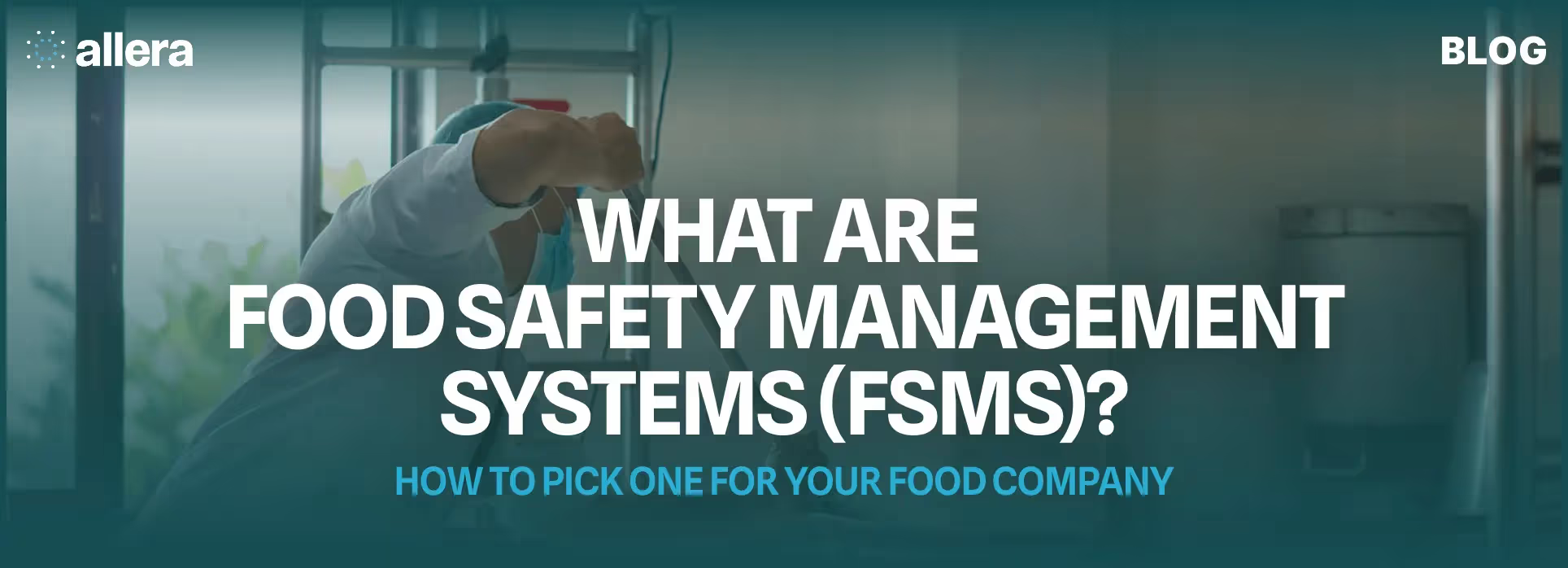

What are Food Safety Management Systems (FSMS)?: How to pick one?

Most food companies think they’re safe—until they’re not.
The truth is, food safety disasters don’t start with poisoned products or failed inspections. They start long before that—with broken systems, ignored paperwork, and blind trust in processes that only look good on paper.
Food Safety Management Systems (FSMS) aren’t just another bureaucratic hoop. They’re the thin line between a thriving brand and a front-page scandal. And the companies that treat FSMS as a checkbox are the ones most likely to end up as tomorrow’s cautionary tale.
By the end of this article, you’ll understand the key principles of FSMS and know how to choose the right system to protect your business with confidence.
What is a Food Safety Management System?
A Food Safety Management System (FSMS) is a comprehensive, systematic approach to identifying, preventing, and controlling food safety hazards throughout your entire operation. Think of it as your organization's blueprint for producing safe food consistently, from raw material sourcing to final product distribution.
The purpose of a food safety management system is multifaceted: it protects public health, ensures regulatory compliance, maintains product quality, and safeguards your business reputation.
According to the World Health Organization, foodborne diseases cause an estimated 420,000 deaths annually, making effective food safety management literally a matter of life and death.
Modern FSMS solutions go beyond traditional paper-based approaches by leveraging technology to create intelligent, responsive systems. These digital platforms can automatically track temperature deviations, send real-time alerts when critical limits are exceeded, and maintain comprehensive audit trails that satisfy the most stringent regulatory requirements. The evolution from manual processes to automated systems represents a fundamental shift in how food companies approach safety management.
Understanding the Legal Framework
Food safety management systems aren't just best practices—they're legal requirements in most jurisdictions. In the United States, food safety modernization act (FSMA), mandates that food facilities implement a food safety plan that includes risk-based preventive controls. Similarly, the European Union requires all food businesses to implement procedures based on HACCP principles under Regulation 852/2004.
These regulatory frameworks recognize that food safety is too critical to leave to chance. They require documented systems, trained personnel, and regular verification that controls are working effectively. Companies that fail to implement adequate FSMS face serious consequences, including regulatory action, product recalls, and potential criminal liability in cases of severe negligence.
Core Components of an Effective FSMS
Interactive Communication
Effective communication forms the backbone of any successful food safety management system. This includes establishing clear protocols for internal communication among teams and external communication with suppliers, customers, and regulatory bodies. As outlined in ISO 22000 standards, interactive communication builds trust throughout the entire supply chain.
Prerequisite Programs (PRPs)
These foundational elements create the basic hygienic environment necessary for safe food production. PRPs include:
- Good Manufacturing Practices (GMPs)
- Sanitation Standard Operating Procedures (SSOPs)
- Pest control measures
- Personal hygiene protocols
- Equipment maintenance and calibration
HACCP Principles Integration
Hazard Analysis and Critical Control Points (HACCP) provides the systematic framework for identifying biological, chemical, and physical hazards. This seven-step approach known as the 7 HACCP Principles, includes conducting hazard analysis, determining critical control points, establishing critical limits, implementing monitoring procedures, and planning corrective actions.
System Management
This encompasses the organizational structure, leadership commitment, and continuous improvement processes that ensure your FSMS remains effective and evolves with changing regulations and business needs. Effective system management includes regular management reviews, internal audits, and corrective action procedures that address both immediate issues and systemic improvements.
The management component also involves establishing clear roles and responsibilities throughout the organization. This includes designating a food safety team with appropriate authority and resources, ensuring that food safety objectives are aligned with business goals, and creating accountability mechanisms that drive performance at all levels.
Documentation and Record Keeping
A critical but often overlooked component of effective FSMS is comprehensive documentation. This includes not only written procedures and work instructions but also records that demonstrate ongoing compliance with established controls. Modern digital systems excel in this area by automatically generating timestamped records, tracking document revisions, and ensuring that the most current versions of procedures are always available to staff.
Effective documentation serves multiple purposes: it provides consistency in training new employees, serves as evidence of due diligence during regulatory inspections, and creates the historical data necessary for trend analysis and continuous improvement. The key is striking the right balance between comprehensive documentation and practical usability—systems that are too complex or burdensome often fail because staff find workarounds rather than following prescribed procedures.
ISO 22000: The Global Standard for Food Safety Excellence
ISO 22000 represents the internationally recognized benchmark for food safety management systems. This standard combines HACCP principles with ISO 9001 quality management elements, creating a comprehensive framework applicable to organizations of any size within the food chain.
Research from Spain's food sector reveals that companies implementing ISO 22000 are primarily driven by internal motivations to improve efficiency, productivity, and quality—not just external compliance pressures.
The study found that 87.7% of companies implementing ISO 22000 were small and medium enterprises, demonstrating that effective food safety management isn't limited to large corporations.
The standard's four core principles—interactive communication, system management, prerequisite programs, and HACCP—work together to create robust food safety controls that facilitate international trade and build consumer confidence.
ISO 22000 vs. Other Standards
While ISO 22000 provides a comprehensive framework, it's important to understand how it relates to other food safety standards. FSSC 22000, for example, builds upon ISO 22000 by adding specific prerequisite program requirements and is recognized by the Global Food Safety Initiative (GFSI). SQF (Safe Quality Food) and BRC (British Retail Consortium) standards offer alternative approaches that may be preferred by certain retailers or geographic regions.
The choice between standards often depends on customer requirements, market access needs, and organizational complexity. Many large food companies find value in implementing multiple standards or choosing schemes that provide mutual recognition. The key is selecting standards that align with your business objectives while providing the rigor necessary to ensure food safety.
Certification Process and Benefits
Achieving ISO 22000 certification involves a structured process that typically takes 6-18 months depending on organizational readiness. The process begins with gap analysis to identify areas where current practices don't meet standard requirements, followed by system development, implementation, and internal auditing before engaging a third-party certification body.
The benefits of certification extend far beyond compliance. Certified organizations often report improved operational efficiency, reduced waste, better supplier relationships, and enhanced market access. Perhaps most importantly, certification provides a framework for continuous improvement that helps organizations stay ahead of evolving food safety challenges.
Digital Transformation in Food Safety Management
The food safety landscape is experiencing unprecedented digital transformation.
According to IFT's 2025 Technology Outlook, approximately 50% of industry professionals plan to invest in artificial intelligence and automation technologies for food safety applications.
Real-Time Monitoring and IoT Integration
Smart sensors and Internet of Things (IoT) devices are revolutionizing how food companies monitor critical control points. Real-time continuous monitoring technologies for temperature, humidity, and gas levels are expected to receive significant investment in 2025, enabling proactive rather than reactive food safety management. Monitoring capabilities are especially important for TCS foods that must remain in safe zones during transport.
AI-Powered Risk Assessment
Artificial intelligence is becoming increasingly sophisticated in analyzing vast datasets to identify patterns and predict potential food safety risks. These technologies can automate routine safety checks, detect anomalies in production processes, and optimize cleaning schedules.
Blockchain for Enhanced Traceability
Blockchain technology provides tamper-proof records of food supply chains, enabling rapid response to contamination incidents and building consumer trust through transparent traceability.
Mobile Technology and Field Applications
The proliferation of smartphones and tablets has revolutionized food safety data collection, particularly for companies with distributed operations like farms, processing facilities, and distribution centers. Mobile applications allow real-time data entry, photo documentation of conditions, and immediate access to procedures and specifications regardless of location.
These mobile solutions are particularly valuable for temperature monitoring during transportation, conducting supplier audits, and managing food safety inspections. The ability to sync data immediately to central systems ensures that management has real-time visibility into operations across all locations, enabling faster decision-making and more effective resource allocation.
Integration with Enterprise Systems
Modern FSMS solutions don't operate in isolation—they integrate seamlessly with existing enterprise resource planning (ERP), quality management, and supply chain systems. This integration eliminates data silos and provides a holistic view of operations that spans from procurement through production to distribution.
Such integration enables sophisticated analytics that can identify correlations between different operational parameters. For example, a system might identify that certain supplier lots correlate with higher defect rates, or that specific environmental conditions predict equipment failures that could impact food safety.
Supply Chain Software Integration for Food Safety
Modern food safety management extends far beyond facility walls—it encompasses your entire supply chain. Supply chain software for food and beverage companies provides end-to-end visibility and control, enabling better collaboration with suppliers and faster response to disruptions.
Supplier Management Automation
Digital supplier management platforms eliminate manual tracking and paper-based verification processes. Companies like Wildway Foods have experienced dramatic improvements after implementing automated supplier management systems, reducing audit preparation time and improving document accuracy.
The transformation at Wildway demonstrates the tangible benefits of modern supplier management platforms. Before implementing digital solutions, they faced frequent human errors and time-consuming manual processes. With automated systems, they achieved enhanced accuracy and completeness of documents while gaining real-time visibility into supplier processes.
Compliance Documentation
Document control systems ensure that all food safety records are properly maintained, timestamped, and audit-ready. This digital approach eliminates the risk of lost paperwork and provides real-time visibility into compliance status across all operations.
Vendor Qualification and Performance Monitoring
Beyond basic document management, modern supply chain software enables sophisticated vendor qualification processes that evaluate suppliers across multiple dimensions including food safety performance, delivery reliability, quality metrics, and regulatory compliance status. These systems can automatically flag suppliers who fall below threshold performance levels and trigger corrective action processes.
Performance monitoring extends beyond initial qualification to ongoing assessment. Automated scorecards track key performance indicators, trend analysis identifies deteriorating performance before it becomes critical, and predictive analytics can identify suppliers at risk of future problems. This proactive approach to supplier management significantly reduces the likelihood of supply chain disruptions and food safety incidents.
Global Supply Chain Complexity
Today's food supply chains often span multiple countries, each with different regulatory requirements, cultural practices, and infrastructure capabilities. Managing food safety across such complex networks requires sophisticated systems that can adapt to local requirements while maintaining global standards.
Digital platforms excel in this environment by providing centralized visibility with localized flexibility. They can accommodate different languages, currencies, and regulatory frameworks while ensuring that core food safety principles are maintained throughout the network. This capability is essential for companies seeking to leverage global sourcing opportunities while maintaining rigorous food safety standards.
Benefits of Implementing a Comprehensive FSMS
Consumer Protection and Public Health
The primary benefit of any food safety management system is protecting consumers from foodborne illnesses. Effective FSMS implementation creates multiple barriers against contamination, ensuring that unsafe products never reach consumers.
The CDC estimates that 1 in 6 Americans gets sick from foodborne illnesses each year, highlighting the urgent need for robust food safety management. (CDC – Food Safety)
Beyond protecting public health, modern FSMS solutions provide comprehensive risk mitigation strategies that address both immediate threats and long-term sustainability challenges. Digital platforms enable proactive monitoring that can identify potential issues before they escalate into serious safety incidents.
Regulatory Compliance and Risk Mitigation
A well-designed FSMS helps organizations stay ahead of evolving regulations. With the FDA's New Era of Smarter Food Safety Blueprint emphasizing technology and data analytics, companies with digital FSMS solutions are better positioned for compliance.
Brand Protection and Market Access
Food safety incidents can devastate brand reputation and close market opportunities. ISO 22000 certification opens doors to international markets and demonstrates commitment to excellence.
Operational Efficiency and Cost Reduction
Digital FSMS solutions reduce manual labor, minimize waste, and prevent costly recalls.
Studies show that automation can increase productivity by up to 20% in food manufacturing operations.
The cost benefits extend beyond direct labor savings. Automated systems reduce paperwork, eliminate duplicate data entry, and minimize errors that require costly corrections. They also enable more efficient use of resources by optimizing scheduling, reducing overproduction, and minimizing waste through better inventory management.
Perhaps most significantly, effective FSMS implementation can prevent the catastrophic costs associated with food safety incidents. A single recall can cost millions of dollars in direct costs and immeasurable damage to brand reputation. The investment in robust FSMS technology is typically recovered many times over through avoided incidents and improved operational efficiency.
Supply Chain Resilience
Recent global events have highlighted the importance of supply chain resilience in maintaining food safety. FSMS solutions contribute to resilience by providing visibility into supplier performance, enabling rapid identification of alternative sources when disruptions occur, and maintaining food safety standards even when normal processes are disrupted.
Resilient systems also include contingency planning for various scenarios, from natural disasters to regulatory changes. Digital platforms can model different scenarios and provide decision support for maintaining operations while preserving food safety integrity.
Implementation Best Practices
Leadership Commitment and Culture Development
Successful FSMS implementation requires genuine commitment from senior leadership. Creating a food safety culture that prioritizes prevention over reaction is essential for long-term success.
Comprehensive Gap Assessment
Before implementing new systems, conduct thorough assessments of current operations, supply chains, and regulatory obligations. Understanding existing strengths and weaknesses provides the foundation for targeted improvements.
Employee Training and Engagement
Every FSMS trend requires employee understanding. Regular training on requirements, responsibilities, and processes ensures that your team can effectively execute food safety protocols.
Technology Integration Strategy
Choose solutions that integrate seamlessly with existing operations. Platform-based approaches like Allera's Food QMS eliminate the need for multiple standalone tools while providing integrated functionality across all food safety disciplines.
The success of integrated platforms lies in their ability to connect previously siloed processes.
Change Management and Organizational Readiness
Successful FSMS implementation requires more than just technology—it demands organizational change management.
This includes preparing employees for new processes, addressing resistance to change, and ensuring that the organization's culture supports the new system.
Effective change management starts with clear communication about why the new system is necessary and how it will benefit both the organization and individual employees. It includes comprehensive training programs, ongoing support during the transition period, and recognition systems that reward adoption and compliance.
The most successful implementations involve employees in the design process, incorporating their feedback and expertise to create systems that are both effective and practical. This participatory approach not only improves system design but also builds buy-in and reduces resistance to change.
Pilot Programs and Phased Implementation
Rather than attempting to implement comprehensive FSMS across an entire organization simultaneously, many companies find success with pilot programs that test new systems in limited environments before broader rollout. This approach allows for refinement of processes, identification of unexpected challenges, and demonstration of benefits that can build support for broader implementation.
Phased implementation can follow various strategies: by facility, by product line, by process area, or by functional component.
The key is selecting an approach that minimizes disruption while maximizing learning opportunities and building momentum for subsequent phases.
Future Trends in Food Safety Management
Predictive Analytics and Machine Learning
Advanced analytics will increasingly enable proactive risk identification before problems occur. Machine learning algorithms will analyze historical data patterns to predict potential contamination sources and optimize preventive measures.
These AI-powered systems represent the next evolution in food safety management, moving beyond reactive compliance to predictive prevention. By analyzing vast datasets from multiple sources, these systems can identify subtle patterns that human operators might miss, enabling intervention before safety issues develop.
Personalized Food Safety Guidance
Emerging technologies will enable customized food safety recommendations based on individual dietary needs, health conditions, and consumption patterns.
Climate-Resilient Food Safety
Climate change impacts on agriculture will require adaptive food safety measures and enhanced monitoring of environmental factors affecting food production.
Sustainable Integration
Sustainability and food safety are becoming increasingly interconnected, with eco-friendly packaging and responsible sourcing becoming integral to comprehensive food safety strategies.
Emerging Food Technologies
The rise of alternative proteins, novel processing technologies, and personalized nutrition creates new food safety challenges that traditional FSMS approaches may not adequately address. These emerging technologies require adaptive frameworks that can evaluate new types of hazards and develop appropriate controls.
For example, plant-based meat alternatives may have different microbiological profiles than traditional meat products, requiring modified HACCP plans. Similarly, technologies like 3D food printing or personalized nutrient blending create new contamination pathways that must be understood and controlled.
Regulatory Evolution and Global Harmonization
Food safety regulations continue to evolve, with increasing emphasis on prevention, traceability, and data-driven decision making. The FDA's New Era of Smarter Food Safety initiative exemplifies this trend, emphasizing the use of technology to create more responsive and effective food safety systems.
Global harmonization of food safety standards is also progressing, driven by international trade requirements and shared recognition that foodborne diseases don't respect national boundaries. This harmonization creates opportunities for companies with robust FSMS to access global markets more easily while also raising expectations for food safety performance.
Choosing the Right FSMS Solution
When evaluating food safety management systems, consider these critical factors:
Scalability and Flexibility: Your FSMS should grow with your business and adapt to changing regulations. Cloud-based solutions offer the flexibility to scale operations across multiple locations.
Integration Capabilities: Look for platforms that integrate with existing quality management systems, supplier networks, and operational tools to create seamless workflows.
User-Friendly Design: Team adoption is crucial to the success of FSMS. User-friendly platforms minimize training requirements and reduce implementation resistance. As one food safety director noted about Allera
"The platform is user-friendly, customizable, and integrates seamlessly without extra tools... The minimal training required made the transition easy, and the incredible support team gave us confidence every step of the way."
Jenny Cisneros, Quality Assurance Director at Epicurean Butter.
This emphasis on user experience reflects a broader industry recognition that even the most sophisticated food safety technology is worthless if employees don't use it consistently. Modern platforms like Allera prioritize intuitive design and seamless workflows that make compliance feel natural rather than burdensome.
Compliance Support: Ensure your chosen solution supports relevant standards like ISO 22000, FSSC 22000, or SQF, depending on your industry requirements and market focus.
Return on Investment Considerations
When evaluating FSMS solutions, it's important to consider both direct and indirect costs and benefits. Direct costs include software licensing, implementation services, training, and ongoing support. Direct benefits include reduced labor costs, improved efficiency, and avoided recall expenses.
Indirect benefits often provide the greatest return on investment but can be harder to quantify. These include improved supplier relationships, enhanced brand reputation, access to new markets, and reduced insurance costs. Many companies also find that robust FSMS implementation improves employee morale and retention by creating clearer processes and reducing the stress associated with compliance uncertainty.
The key to maximizing ROI is selecting solutions that address multiple business objectives simultaneously. For example, a system that improves food safety while also streamlining operations and enhancing supplier relationships provides compound benefits that justify higher initial investments.
Customization vs. Standardization
One common decision point in FSMS selection is the degree of customization required versus the benefits of standardized approaches. Highly customized systems can address unique operational requirements but may be more expensive to implement and maintain. Standardized systems offer lower costs and faster implementation but may require process changes to achieve optimal benefits.
The best approach often involves selecting systems that provide standardized core functionality with customization options for critical differentiators. This hybrid approach balances efficiency with flexibility while minimizing long-term maintenance complexity.
FAQs
What is the 7 step system used to manage food safety?
The 7-step system refers to the HACCP (Hazard Analysis and Critical Control Points) principles mandated by FDA and USDA. These steps include: conduct hazard analysis, determine critical control points (CCPs), establish critical limits, establish monitoring procedures, establish corrective actions, establish verification procedures, and establish record-keeping and documentation procedures. HACCP forms the foundation of preventive food safety management in manufacturing facilities.
How to implement a food safety management system?
Implementation requires systematic planning and execution:- Assemble a multidisciplinary HACCP team with food safety expertise- Conduct comprehensive hazard analysis of all products and processes- Identify and validate critical control points through scientific data- Establish measurable critical limits based on regulatory requirements- Design monitoring procedures with defined frequencies and responsibilities- Develop corrective action protocols for deviations- Create verification schedules including calibration and validation activities- Establish documentation systems for record-keeping and traceability
What is an example of a food safety system?
HACCP serves as the primary example of a comprehensive food safety system. A bakery manufacturing bread would identify biological hazards like Salmonella in flour, establish CCPs at the baking step with critical limits of 200°F internal temperature, monitor temperatures continuously, document corrective actions when limits are exceeded, verify system effectiveness through testing, and maintain detailed records. Additional systems include SQF, BRC, and FSSC 22000 certification programs.
How to create a safety management system?
Creating an effective food safety management system involves establishing prerequisite programs first, then building HACCP on that foundation. Begin with management commitment and resource allocation. Develop standard operating procedures for sanitation, maintenance, and training. Form a qualified HACCP team and conduct thorough hazard analysis. Design monitoring systems with clear responsibilities and frequencies. Implement verification activities including internal audits and supplier verification. Establish robust documentation and record-keeping systems to demonstrate compliance and support continuous improvement efforts.
What are the three food safety management tools?
The three primary food safety management tools are prerequisite programs (PRPs), HACCP systems, and food safety culture programs. PRPs include sanitation, pest control, and equipment maintenance that create baseline conditions. HACCP addresses specific biological, chemical, and physical hazards through critical control points. Food safety culture ensures employee engagement and continuous improvement through training, communication, and accountability measures.




.avif)

.avif)

.avif)
.avif)

